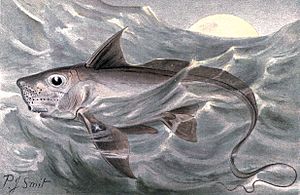Rabbit fish facts for kids
Quick facts for kids Rabbit fish |
|
|---|---|
 |
|
| Conservation status | |
| Scientific classification | |
| Genus: |
Chimaera
|
| Species: |
monstrosa
|
Chimaera monstrosa, often called the rabbit fish or rat fish, is a fascinating deep-sea creature. It lives in the northeast Atlantic Ocean and the Mediterranean Sea. This fish is a type of cartilaginous fish, which means its skeleton is made of cartilage, not bone, like sharks.
The rabbit fish gets its name from its unique look. It has a big head with large eyes and nostrils, and a small body that tapers down. These features make its head look a bit like a rabbit's! These fish can grow up to 1.5 metres (5 ft) long. They can also live for a long time, sometimes up to 30 years.
Contents
What Does the Rabbit Fish Look Like?
The rabbit fish shares some features with its relatives, the sharks. It has a large head and a body that gets thinner towards its whip-like tail. Its snout is short, and its mouth hangs slightly below.
The main dorsal fin on its back is tall and shaped like a triangle. A spine runs along its back and connects to the upper part of its tail fin. Be careful, this spine is a little bit poisonous and can cause a painful sting!
One special thing about the rabbit fish is its anal fin. This fin is clearly separate from its lancet-shaped tail fin. The fish's body is silver-green with brown spots. It also has white stripes that go in different directions. You can clearly see a distinct lateral line on its head.
Rabbit fish can grow up to 1.5 m (4.9 ft) long. They can weigh around 2.5 kg (5.5 lb). These fish grow slowly and live for many years. Studies show that male rabbit fish can live up to 30 years, and females up to 26 years. They usually become old enough to reproduce around 11 to 13 years of age.
Where Do Rabbit Fish Live?
Rabbit fish are found in the Mediterranean Sea and the eastern parts of the Atlantic Ocean. Their home range stretches from Morocco in the south all the way up to Norway and Iceland in the north.
These fish live in deep waters, usually between 50 to 1,000 metres (160 to 3,280 ft) down. They are most common on the upper and middle parts of the continental slope, at depths of 300 to 500 metres (980 to 1,640 ft). The water in these areas is usually cool, between 4.7–8.0 °C (40.5–46.4 °F). Sometimes, in the summer, rabbit fish move closer to shore to lay their eggs. They might go as shallow as 100 m (330 ft) for this.
What Do Rabbit Fish Eat?
Chimaera monstrosa is known as a benthophagous species. This means they mostly eat animals that live on the seafloor. Their diet includes creatures like crabs, molluscs (like snails and clams), octopuses, sea-worms, and sea urchins.
However, rabbit fish are also opportunistic feeders. This means they will eat what is available. What they eat can change depending on their size. Smaller rabbit fish (under 22 cm (9 inches)) mainly eat small crustaceans called amphipods. Medium-sized fish (between 22 and 46 cm (9 and 18 inches)) eat both amphipods and decapods (like crabs and shrimp). Larger rabbit fish (over 46 cm or 18 inches) mostly eat decapods.
Their diet can also change based on where they live and how deep the water is. This shows that even though they might prefer certain foods, these deep-sea fish can adapt their diet to find food in their environment.
Rabbit Fish Life Cycle
Rabbit fish have separate sexes from birth. They reproduce through internal fertilization, meaning the male fertilizes the female's eggs inside her body. Males have a small, club-like structure on their head with sharp denticles, which helps them during mating.
These fish are oviparous. This means the baby fish develop inside eggs, which are then laid outside the female's body.
Male and female rabbit fish often live in different depths of water. Males prefer waters around 500–600 m (1,600–2,000 ft) deep. Females usually live deeper, around 800 m (2,600 ft). However, females will move up to depths of 500–600 m (1,600–2,000 ft) to mate with males. After mating, the females swim closer to shore in the spring or summer to lay their eggs.
Protecting the Rabbit Fish
The Chimaera monstrosa is listed as vulnerable by the IUCN Red List. This means their population is decreasing, and they could become endangered.
Rabbit fish have a lot of oil in their livers. This oil has been used to make dietary supplements. However, most of the time, rabbit fish are caught by accident when people are fishing for other species. This is called "bycatch," and it is a big reason why their numbers are going down. Protecting their deep-sea habitats and reducing bycatch are important steps to help these unique fish survive.
Images for kids
See also
 In Spanish: Chimaera monstrosa para niños
In Spanish: Chimaera monstrosa para niños



